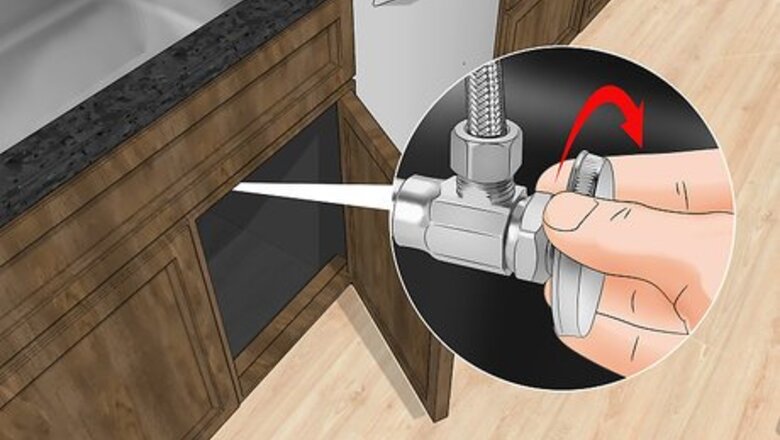
views
- Shut off the hot and cold water supply valves, then use a wrench to disconnect the supply lines connected to them.
- Remove the nuts from the old faucet, pull it out, and clean any grime below it. Assemble the new faucet and cover any excess holes with an escutcheon plate.
- Feed the supply tubes into the faucet hole and position the new faucet, then tighten the nuts underneath. Attach the new water supply line hoses to the hot and cold valves.
Disconnecting the Water Supply Lines
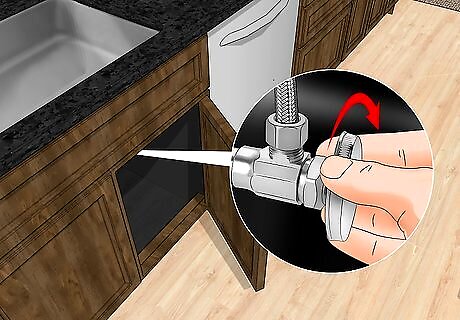
Shut off the hot and cold water supply valves under the sink. Open the cabinets under your sink and find the knobs that control the water valves attached to your pipes. Turn the knobs so they’re perpendicular to the pipes to close them. If you don’t have water valves under your sink, turn off the main water line. If you have a garbage disposal under your sink, unplug it. If you have an electrical outlet below your sink, turn off the breaker that connects to it before you remove the old faucet. If you have difficulty turning the valves, use a rag or pair of pliers to improve your grip. Clear out all supplies and products under the sink.
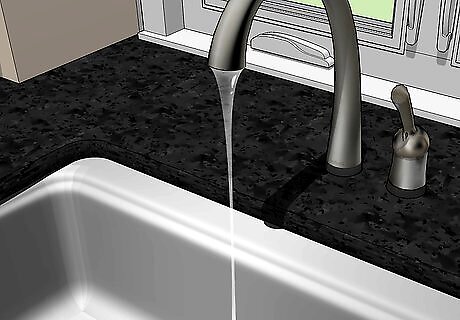
Turn on your faucet to relieve any water pressure. After turning off the hot and cold water supply valves, lift or turn the handles to your existing faucet to relieve any pressure in the lines and clear out any water that might be trapped in the pipes. Keep a shallow bowl or pan and a couple of old towels nearby to catch water while you’re working.

Disconnect the supply lines that run from the faucet to the hot and cold valves. The supply lines are hoses connected to the hot and cold pipes with hexagonal nuts. Use an adjustable wrench to unscrew the nuts from the hoses until you can detach them completely. Keep one hand on the water pipe as you loosen the supply lines to make sure you don’t damage any connections behind the cabinet. Home improvement specialist Allen Lee says that if the “angle stops that turn the water on and off” are leaking and haven’t been touched in years, “you're going to want to definitely have that looked at by someone who's trained in that and knows how to replace angle stops if that is needed.”
Removing the Old Faucet
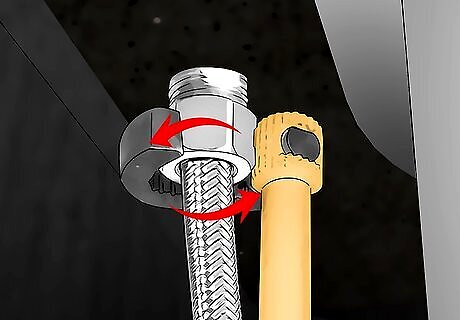
Use a basin wrench to remove the nuts from the faucet. Adjust the length of the wrench handle and place the jaws of the wrench around the nuts connecting your faucet to the hose. Turn the wrench counterclockwise to loosen the nut completely. If you have a sprayer, use the wrench to take off the nut connecting the diverter to the sprayer hose, too. A basin wrench is a long-handled tool that can make it easier to reach underneath your sink. A single-handle faucet will typically be connected to a single shank that contains the hot and cold supply lines. A 2-handle center-set faucet will have the mounts on both supply lines. If any nuts or mounting hardware is rusted or difficult to remove, apply a penetrating oil to loosen it. You may have to apply it multiple times before you can get the nut off. Tip: Have someone help you hold the faucet from above so it doesn’t spin while you loosen the nut.
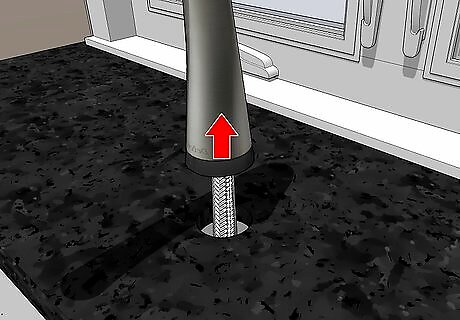
Pull the faucet out of the sink and clean any grime or residue. Once you remove the nuts and mounting hardware, simply pull the faucet up and out of the holes in the top of your sink. Use a multipurpose cleaner and a cloth to clean any grime that may have developed around the old faucet. You may have to apply pressure to break the caulk seal. You can also scrape off any caulk or plumber’s putty with a putty knife—just be careful not to scratch the sink or countertop. If you’re having trouble removing any grime, let the cleaner sit on it for 1 minute before trying to scrub it off again.
Installing the New Faucet
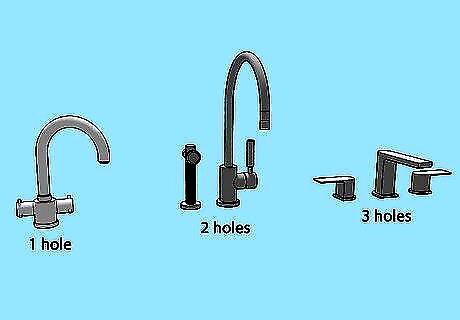
Buy a faucet that fits the number of holes in your sink. The number and placement of the holes can limit the kind of faucet you can install. However, some setups, like a wide set faucet where the handles and faucet and separate individual units, can be installed with any number of sink holes. If you have 3 holes in your sink, measure between the center of the first hole and the center of the second hole. This is called the “spread,” which determines what size faucet you can install. A single-handle center-set faucet can be mounted directly in 1 hole, or you can buy an escutcheon plate to cover up the 2 outside holes in a 3 hole sink. A 2-handle centerset faucet has separate hot and cold handles that are connected to the base and fit cleanly into 3-holed sinks.Tip: If you have additional holes left in your sink, you can use them for a built-in soap dispenser or a sink sprayer. If you’d like a sprayer but don’t have enough holes, you can buy a pull-out sprayer that stretches out from the spout of the faucet.
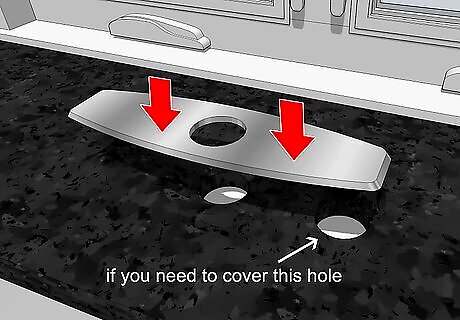
Assemble the faucet and cover any extra holes with an escutcheon plate. Follow the manufacturer’s instructions for the proper assembly of your specific sink faucet. If you’re not using some of the holes at the top of your sink, use the included escutcheon (or deck) plate or buy a separate one to cover them. Wrap 3 layers of Teflon tape around the threading of the supply tubes that came with your faucet, then screw the supply tubes onto the faucet fixture using an adjustable wrench. Most escutcheon plates included with sink faucets also have a rubber gasket that attaches underneath the plate to seal the holes at the top of your sink. If the base of your faucet doesn’t come with a rubber gasket, apply a bead of silicone caulk or plumber’s putty to the faucet base.
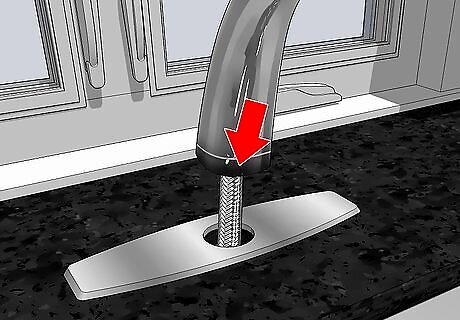
Feed the supply tubes into the faucet hole and position the new faucet. Align the faucet over the center hole at the top of your sink and feed the tubes through one at a time so they’re easier to manage. After the tubes are in, lower the faucet onto the sink and hold it in the position where you want to secure it.
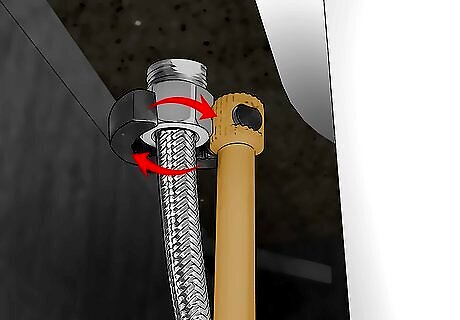
Secure the faucet by tightening the nuts with your basin wrench. Have a helper hold the faucet from above the sink so it doesn’t shift or move around. Screw the nut with your fingers until it almost hits the underside of the sink, then tighten down the mounting screws evenly until the faucet is tight against the underside of the sink. If your faucet assembly doesn’t have mounting screws, simply use a basin wrench to screw on the nut until it’s tight against the underside of the sink. Try to avoid over-tightening the nuts.
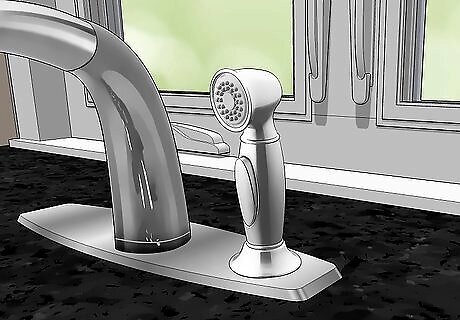
Connect the sink sprayer to the faucet if you have one. Set the sprayer base in one of the holes in your sink and screw on the mounting nut to secure it in place. Feed the sprayer hose through the base and attach the end of the hose to the bottom port on your faucet. Depending on the type of sprayer, you may just have to push the hose in place or screw it together.
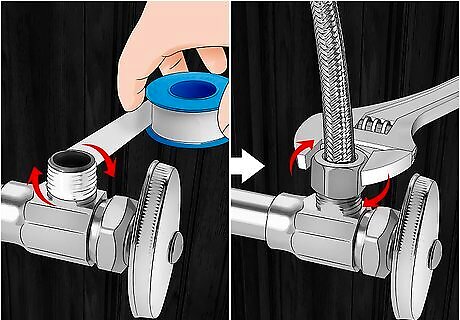
Attach the water lines to the faucet supply hoses. Hold the supply hoses with the nuts attached to them from the faucet up to the hot and cold water valves. Wrap 3 layers of Teflon tape around the threading of both valves in the same direction as you’d tighten the nuts in. Screw the nuts onto the valves with your fingers and tighten it down with an adjustable wrench. Keep one hand on the pipe for the water supply valve running into the wall as you tighten the valves so you don’t damage any connections. For faucets with 2 handles, make sure the hot water line is connected to the side that controls hot water, and the cold water line is attached to the cold handle. If you had to disconnect a garbage disposal earlier, plug it back in.
Cleaning out Debris & Checking for Leaks
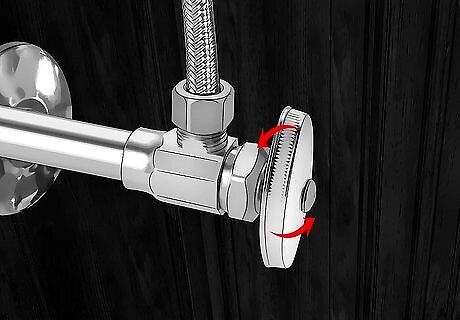
Turn the water on and check for leaks under the sink. Turn on the hot and cold water valves under the sink and test out your faucet and sprayer. With the water running from the tap, check if there are any leaks in any of your faucet connections. If you find a leak, use an adjustable wrench to tighten the connections until it stops. Keep a towel or bucket underneath your valves until you’re sure they don’t leak anymore.
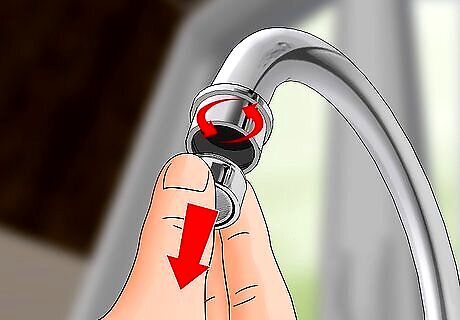
Unscrew the aerator from the end of the faucet to flush out debris. The aerator is a small layer of metal mesh used to control the water flow. Twist the aerator counterclockwise to remove it from the end of your faucet. Check the instruction manual for your faucet to see how to remove it from your exact model.
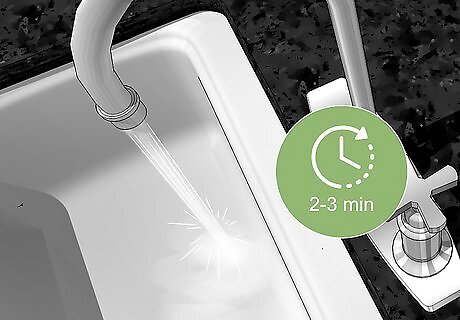
Turn on your faucet and let the water run for 1-3 minutes. Lift or turn the handles on your faucet so the water runs out. Keep the faucet on for a few minutes so any debris or dust inside is flushed out of the water lines. If your faucet has 2 handles, turn both of them on to clear out all of the lines.Tip: Check underneath your sink again while the water is running to see if you notice any leaks. If so, tighten the nuts on the water lines. Afterward, turn off your faucet and screw the aerator back on. Now you can use your new faucet!


















Comments
0 comment